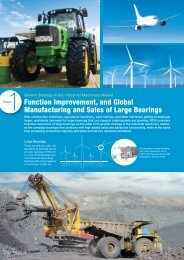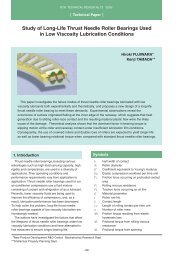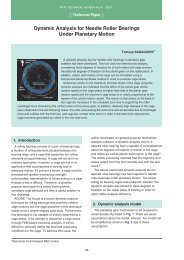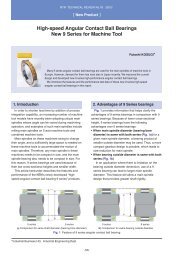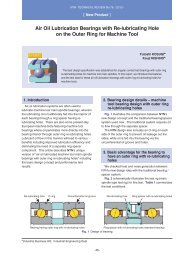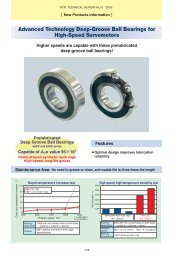Special Issue; Products for Industrial Machinery - NTN
Special Issue; Products for Industrial Machinery - NTN
Special Issue; Products for Industrial Machinery - NTN
Create successful ePaper yourself
Turn your PDF publications into a flip-book with our unique Google optimized e-Paper software.
Development of a New Grease Lubrication System <strong>for</strong> Machine Tool Main Spindles<br />
2. Structure of the New Grease<br />
Lubrication System<br />
To achieve high speed and long life with a bearing<br />
by using grease lubrication, it is necessary to not only<br />
provide a sufficient amount of lubricant <strong>for</strong> a bearing<br />
while running at a high speed but also to maintain the<br />
supply of grease base oil from a limited amount of<br />
prefilled grease. With the authors’ newly developed<br />
grease lubrication system, the base oil in the grease is<br />
actively separated while the bearing is running, and<br />
this separated base oil is steadily supplied to the<br />
raceway surface of the bearing. The bearing structure<br />
of the authors’ new grease lubrication system is<br />
illustrated schematically in Fig. 1. As a part of the<br />
outer ring spacer, a cavity is <strong>for</strong>med in front of the<br />
bearing and the grease prefills this space. At the same<br />
time, this provides a shouldered surface near the<br />
contact point between the rolling elements and the<br />
outer ring raceway. In addition, a thin axial flow path is<br />
<strong>for</strong>med between the shouldered surface and the end<br />
point of the grease chamber, thus connecting the<br />
grease chamber to the raceway surface.<br />
For this structure, the authors considered a base oil<br />
delivery mechanism that works as follows. The<br />
running bearing generates heat, causing the<br />
temperature of the grease in the grease chamber to<br />
increase and the base oil in the grease to separate<br />
from the thickener. As the temperature increases, the<br />
pressure in the grease chamber also increases,<br />
causing the base oil from the above-mentioned axial<br />
flow path to flow through the clearance on the<br />
shouldered surface, resulting in delivery to the outer<br />
ring raceway surface. As a result, the bearing is<br />
actively lubricated by the base oil delivered to the<br />
outer ring raceway surface.<br />
Clearance on<br />
shouldered surface<br />
Enlarged<br />
view<br />
Outer ring<br />
Outer ring<br />
spacer<br />
3. Experiment Using a Model Test Rig<br />
To investigate the characteristics of base oil delivery<br />
from the grease chamber and verify the base oil<br />
delivery mechanism described in Sec. 2, the authors<br />
used a model in which this base oil delivery<br />
mechanism was applied to an angular contact ball<br />
bearing with a 100 mm bore diameter. The findings<br />
from the experiment are provided below.<br />
3.1 Model test rig and test method<br />
The authors’ model test rig <strong>for</strong> base oil delivery is<br />
schematically illustrated in Fig. 2. The appearance of<br />
the test rig is shown in Photo 1. The radial clearance<br />
in Fig. 2 is indicated on a radius basis. The properties<br />
of the two types of grease developed <strong>for</strong> machine tool<br />
main spindle bearings that were used are summarized<br />
in Table 1. Grease was filled into the grease chamber<br />
via four grease prefilling holes provided on the outer<br />
circumferential surface until the entire space of the<br />
grease chamber was filled. The amount of prefilled<br />
grease was approximately 47 g.<br />
The following characteristics were tested since they<br />
were considered to affect base oil delivery:<br />
• Temperature-dependent variation in the grease<br />
chamber<br />
• Size of radial clearance at the end point<br />
• Type of grease used<br />
Characteristic<br />
Thickener<br />
Base oil<br />
Amount of thickener wt%<br />
Base oil kinematic<br />
viscosity mm/s 2 40˚C<br />
Worked penetration,<br />
60 strokes 60W 25˚C<br />
Spreading consistency<br />
Table. 1 Grease properties<br />
Grease<br />
Grease-A Grease-B<br />
Urea<br />
PAO<br />
Polyol ester<br />
11.2<br />
40.6<br />
Radial clearance<br />
Urea<br />
PAO<br />
Diester<br />
Polyol ester<br />
11.7<br />
40.6<br />
243 280<br />
230 260<br />
Grease prefilling hole<br />
Grease<br />
Grease chamber<br />
Fig. 1 Schematic construction of new lubrication system<br />
40<br />
150<br />
Fig. 2 Sketch of model test rig <strong>for</strong> base oil delivery<br />
-9-



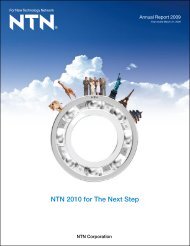
![[New Product] Unit Products for Office Equipment - NTN](https://img.yumpu.com/27154451/1/184x260/new-product-unit-products-for-office-equipment-ntn.jpg?quality=85)
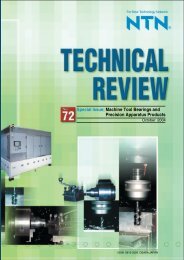
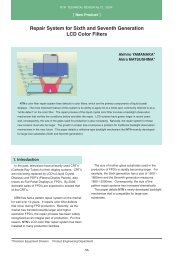
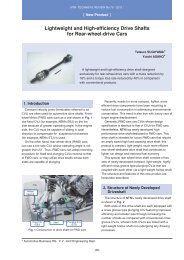
![[New Product] Development of Oil-impregnated Sintered ... - NTN](https://img.yumpu.com/27154427/1/184x260/new-product-development-of-oil-impregnated-sintered-ntn.jpg?quality=85)

